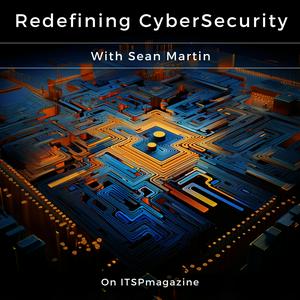Hackers, Policy, and the Future of Cybersecurity: Inside The Hackers’ Almanack from DEF CON and the Franklin Project | A Conversation with Jake Braun | Redefining CyberSecurity with Sean Martin
⬥GUEST⬥Jake Braun, Acting Principal Deputy National Cyber Director, The White House | On LinkedIn: https://www.linkedin.com/in/jake-braun-77372539/⬥HOST⬥Host: Sean Martin, Co-Founder at ITSPmagazine [@ITSPmagazine] and Host of Redefining CyberSecurity Podcast [@RedefiningCyber] | On ITSPmagazine: https://www.itspmagazine.com/sean-martin⬥EPISODE NOTES⬥Cybersecurity is often framed as a battle between attackers and defenders, but what happens when hackers take on a different role—one of informing policy, protecting critical infrastructure, and even saving lives? That’s the focus of the latest Redefining Cybersecurity podcast episode, where host Sean Martin speaks with Jake Braun, former Acting Principal Deputy National Cyber Director at the White House and current Executive Director of the Cyber Policy Initiative at the University of Chicago.Braun discusses The Hackers’ Almanack, a project developed in partnership with DEF CON and the Franklin Project to document key cybersecurity findings that policymakers, industry leaders, and technologists should be aware of. This initiative captures some of the most pressing security challenges emerging from DEF CON’s research community and translates them into actionable insights that could drive meaningful policy change.DEF CON, The Hackers’ Almanack, and the Franklin ProjectDEF CON, one of the world’s largest hacker conferences, brings together tens of thousands of security researchers each year. While the event is known for its groundbreaking technical discoveries, Braun explains that too often, these findings fail to make their way into the hands of policymakers who need them most. That’s why The Hackers’ Almanack was created—to serve as a bridge between the security research community and decision-makers who shape regulations and national security strategies.This effort is an extension of the Franklin Project, named after Benjamin Franklin, who embodied the intersection of science and civics. The initiative includes not only The Hackers’ Almanack but also a volunteer-driven cybersecurity support network for under-resourced water utilities, a critical infrastructure sector under increasing attack.Ransomware: Hackers Filling the Gaps Where Governments Have StruggledOne of the most striking sections of The Hackers’ Almanack examines the state of ransomware. Despite significant government efforts to disrupt ransomware groups, attacks remain as damaging as ever. Braun highlights the work of security researcher Vangelis Stykas, who successfully infiltrated ransomware gangs—not to attack them, but to gather intelligence and warn potential victims before they were hit.While governments have long opposed private-sector hacking in retaliation against cybercriminals, Braun raises an important question: Should independent security researchers be allowed to operate in this space if they can help prevent attacks? This isn’t just about hacktivism—it’s about whether traditional methods of law enforcement and national security are enough to combat the ransomware crisis.AI Security: No Standards, No Rules, Just ChaosArtificial intelligence is dominating conversations in cybersecurity, but according to Braun, the industry still hasn’t figured out how to secure AI effectively. DEF CON’s AI Village, which has been studying AI security for years, made a bold statement: AI red teaming, as it exists today, lacks clear definitions and standards. Companies are selling AI security assessments with no universally accepted benchmarks, leaving buyers to wonder what they’re really getting.Braun argues that industry leaders, academia, and government must quickly come together to define what AI security actually means. Are we testing AI applications? The algorithms? The data sets? Without clarity, AI red teaming risks becoming little more than a marketing term, rather than a meaningful security practice.Biohacking: The Blurry Line Between Innovation and BioterrorismPerhaps the most controversial section of The Hackers’ Almanack explores biohacking and its potential risks. Researchers at the Four Thieves Vinegar Collective demonstrated how AI and 3D printing could allow individuals to manufacture vaccines and medical devices at home—at a fraction of the cost of commercial options. While this raises exciting possibilities for healthcare accessibility, it also raises serious regulatory and ethical concerns.Current laws classify unauthorized vaccine production as bioterrorism, but Braun questions whether that definition should evolve. If underserved communities have no access to life-saving treatments, should they be allowed to manufacture their own? And if so, how can regulators ensure safety without stifling innovation?A Call to ActionThe Hackers’ Almanack isn’t just a technical report—it’s a call for governments, industry leaders, and the security community to rethink how we approach cybersecurity, technology policy, and even healthcare. Braun and his team at the Franklin Project are actively recruiting volunteers, particularly those with cybersecurity expertise, to help protect vulnerable infrastructure like water utilities.For policymakers, the message is clear: Pay attention to what the hacker community is discovering. These findings aren’t theoretical—they impact national security, public safety, and technological advancement in ways that require immediate action.Want to learn more? Listen to the full episode and explore The Hackers’ Almanack to see how cybersecurity research is shaping the future.⬥SPONSORS⬥LevelBlue: https://itspm.ag/attcybersecurity-3jdk3ThreatLocker: https://itspm.ag/threatlocker-r974⬥RESOURCES⬥The DEF CON 32 Hackers' Almanack: https://thehackersalmanack.com/defcon32-hackers-almanackDEF CON Franklin Project: https://defconfranklin.com/ | On LinkedIn: https://www.linkedin.com/company/def-con-franklin/DEF CON: https://defcon.org/Cyber Policy Initiative: https://harris.uchicago.edu/research-impact/initiatives-partnerships/cyber-policy-initiative⬥ADDITIONAL INFORMATION⬥✨ More Redefining CyberSecurity: 🎧 https://www.itspmagazine.com/redefining-cybersecurity-podcastRedefining CyberSecurity Podcast on YouTube:📺 https://www.youtube.com/playlist?list=PLnYu0psdcllS9aVGdiakVss9u7xgYDKYqInterested in sponsoring this show with an ad placement in the podcast? Learn more:👉 https://itspm.ag/podadplc
